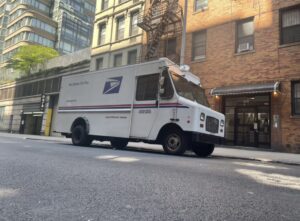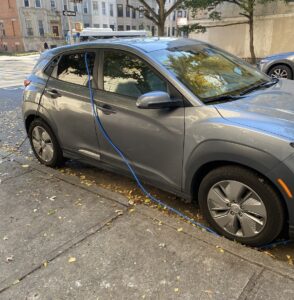(NEW YORK) – Electric Vehicles (EVs) have been hailed as a fail-safe for the clean energy future. The U.S. federal government is seeking to procure enough EVs to power its entire federal fleet of non-combatant vehicles by 2035.
Experts are raising the alarm that the government is not moving fast enough on multiple key issues outside of vehicle procurement. Deserts of charging infrastructure, the current and projected microchip shortages, and battery operation in inclement weather are big obstacles that need to be solved for an all-electric vehicle future. On March 30, four experts talked about the uphill battles the U.S. faces in a digital forum hosted by FedInsider called “Climate Changes the Landscape for Electric Vehicles”.

An old USPS truck – part of an aging fleet that the U.S. federal government intends to electrify. [Credit: Ben Shimkus]
According to the report the U.S. has 675,000 non-tactical vehicles in the entire federal fleet. Around 1% of them are EVs. EV procurement has been a testy subject for portions of the federal government. Most notably, USPS has endured public scrutiny for their recent vehicle purchasing.
According to Phelan, there are only 600 federal charging stations in the entire United States. Overall, they house a measly 2,000 individual chargers for federal vehicles. That is not nearly enough individual stations to support an entire fleet of vehicles.
“If you don’t have charging stations, you eliminate the possibility of switching to an electric vehicle,” Phelan continued. “The infrastructure part is the more complicated part of electrifying the federal fleet… It’s an enormous undertaking. And honestly, it’s a lot more important than the vehicles themselves.”
EV skeptics often point out that battery efficiency is dependent on climate; batteries tend to be best acclimated to moderate temperatures. Colder temperatures make battery efficiency depreciate, while hotter temperatures necessitate the use of more energy-intensive systems. This is suboptimal for a country with vastly different regional climates, like the U.S.

An EV charges in New York City – lack of charging infrastructure forces EV drivers to get creative. [Credit: Kabir Nadkarni]
The federal government is still in the early stages of any shift toward electric vehicles. While experts warn that the U.S. is not prepared for the early parts of the transition, they recognize that this is an opportunity to positively impact U.S. carbon emissions targets.
“It’s incredibly exciting that we are really acting as agents of change,” Phelan said of the federal government’s procurement of EVs. “Someone had to take that bold step, and that someone is us.”

![Public hiking trail to California’s Hollywood sign [Credit: Valeria Garcia]](https://theclick.news/wp-content/uploads/2024/10/USA-FLAG.png)
